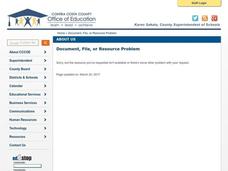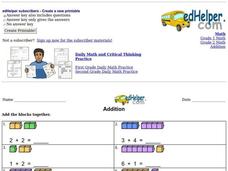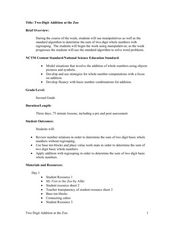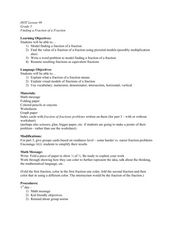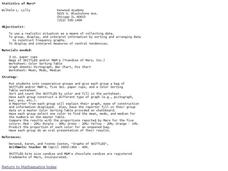Curated OER
Smiling at Two Digit Multiplication!
How do I solve a two-digit multiplication problem? Your class tackles this question by walking through problem solving methods. They first investigates and applies traditional multiplication methods, and they then compare those with...
Curated OER
Candy Math
Second graders in a special education classroom sort candies by color. In groups, they complete various addition problems with the candy and create graphs. They compare and contrast the amounts of candies and answer questions on a...
Curated OER
Addition with Counters
The first of four worksheets, these twelve equations call for students to find the answers by additing single-digit numbers together. There are colorful blocks included for assistance.
Curated OER
Addition: Missing Numbers
Young mathematicians are required to fill in the missing numbers to complete these 12 addition sentences. Colorful counting blocks are displayed for assistance.
Curated OER
Math: Where Do I Put the Elephant?
Students listen to the story, "Harriet Goes to the Circus," to launch into a lesson on positional words, such as over, under, and behind. After clipping out and coloring pictures of circus animals, students place them into a parade line...
Curated OER
Color 9
In this early childhood coloring sheet, learners practice their counting and coloring skills as they color 9 balloons on the worksheet.
Curated OER
Geometry Maze and Coloring Sheet
In this geometry coloring maze worksheet, 3rd graders color a path of rectangles to help a dog ( pictured) to find his way to the dog house. They choose the rectangles out of other geometric shapes such as stars, oval, triangles,...
Virginia Department of Education
Surface Area of a Rectangular Prism
Wrap up a lesson on surface area with a resource that asks scholars to use the idea of wrapping paper to investigate surface area. They draw representations of rectangular prisms on graph paper to find the areas of the respective...
Virginia Department of Education
Similar Figures
How similar do figures have to be to be similar figures? Individuals learn to identify similar figures by verifying that angles are congruent and sides are proportional. Additionally, they match the corresponding parts of similar figures.
Chapman University
The Standard Model Poster
Chemistry classes will appreciate this color-coded, single-page reference sheet for The Standard Model of particle physics. It is divided into two main sections: elementary particles and compound particles, both with their antiparticles....
Virginia Department of Education
Rational Functions: Intercepts, Asymptotes, and Discontinuity
Discover different patterns by making connections between a rational function and its graph. An engaging lesson asks scholars to explore the behavior of different rational functions. Groups discover a connection between the function...
Curated OER
Math Medicine
Young scholars solve real-world problems related to medical careers. They use graphical representations as part of the problem-solving process and work with fractions, decimals, exponents, and metric measurement. A demonstration is...
Curated OER
Doubles Plus One Math Game
Students participate in a dice game. In this doubles activity, students are paired up and use dice to create double facts. Students solve the equations.
Curated OER
Two-Digit Addition at the Zoo
Your second graders explore two digit addition with regrouping. They will investigate problem solving strategies within the context of a trip to the zoo. Multiple resources and assessments are provided.
Lied Center of Kansas
The Ugly Duckling and The Tortoise and the Hare
Both The Ugly Duckling and The Tortoise and the Hare are great additions to an elementary language arts lesson. Young readers focus on the literary elements of each story, including characters and plot development, and apply...
Curated OER
Data With Candy
Students, while utilizing the classroom and the computer lab with a bag of colored candy, gather and interpret data, calculate averages and draw conclusions and draw a bar graph. They estimate how many candies are in the bag, what...
Curated OER
Finding a Fraction of a Fraction
Teach your math class to determine the value of fractions. The group will explore how to break a fractional part into smaller pieces, which helps strengthen their understanding of the part/whole relationship of fractions. A written...
Curated OER
Introduction to Equivalent Fractions
Explore equivalent fractions! Youngters measure the crown of their head with adding tape labeled with various fractions and fractional parts, and compare strips to notice numerical relationships. They fold adding tape in half and color...
Curated OER
Statistics of Mars
Young scholars explore the concept of central tendencies. In this central tendencies lesson, students sort M&M's or Skittles based on color. Young scholars graph their results. Students find the mean, median, and mode of their data.
Curated OER
Linear Equations & Manipulatives
High schooler math pupils review operations and solve linear equations using manipulatives--squares, cubes, circles, and cups. They transfer the operations performed on the manipulatives in equation form.
Curated OER
Usage and Interpretation of Graphs
Cooperative groups are formed for this graphing activity. Each group must construct a graph that represents how many eyelets (the holes for laces in shoes), are present in their group. A whole-class bar graph is eventually constructed...
Curated OER
Symmetry Fun
In this symmetry worksheet, 7th graders identify and complete 12 different lines of symmetry in polygons. First, they color all of the polygons that have a line of symmetry. Then, students circle all of the regular polygons and use the...
Curated OER
Number Fun
Kindergarten counters can demonstrate their understanding of the concepts of the greatest number, the least number, and number sequencing on an illustrated two-page worksheet. There is even a problem that asks class members to color the...
Curated OER
Classifying Angles
In this classifying angles worksheet, 7th graders identify and complete 17 different angles illustrated on the sheet. First, they use the key given to outline each angle. Then, students use a protractor to measure each angle and...



